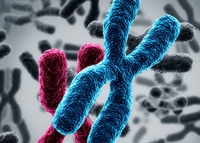Stanford researchers create a new technique to study how we inherit disease
10 Mar 2014
Human reproduction is simple. A sperm cell carries the man's genome into the egg. There, during fertilization, male and female genomes commingle in a way that fuses different traits from each parent into the DNA blueprint for a new human being.
 | |
| The human genetic code is written on DNA, which is packaged into large molecules called chromosomes. Chromosomes from the mother and father commingle to form a child. Depicted here in pink and blue are the chromosomes of the mother and father. Stanford scientists have developed a way to deduce the genetic sequence of each parent's chromosome by performing a new type of analysis on a sample of DNA taken from their offspring. |
Parents aren't perfect. Their genomes may contain disease-causing mutations. Nature tries to protect offspring by gene-mixing. This way if one parent passes on a defective mutation, the other has a chance to contribute a working copy.
Until now, however, there hasn't been an easy way to determine whether an offspring inherited a good working copy of a gene or two defective mutations, a scenario that could cause disease or illness.
In a recent paper in Nature Biotechnology, a research team led by Stanford scientists and engineers describes a new process that can analyse an offspring's DNA and reveal which specific genes were inherited from each parent.
''If you sequence the child you can now tell what traits they inherited from their parents,'' said Michael Snyder, professor and chair of genetics at Stanford and principal author of the study, which was co-authored by Volodymyr Kuleshov, a doctoral student in computer science at Stanford.
DNA is made up of four chemicals – A, T, G and C – strung in a specific order. A person has 6 billion of these chemicals assembled into 46 chromosomes, 23 each from mother and father.
When scientists sequence a person's genome, they break the DNA into small pieces to determine the order of the A, T, G and Cs.
The problem is that current process doesn't reveal all the information needed to ascertain which parts of a person's genome come from which parent. Important variants could come from either the mother's or the father's chromosomes.
The Stanford team used several innovations to provide this missing information on parental inheritance.
First the researchers chopped the DNA into blocks 10,000 letters long. Since modern sequencers can't directly read blocks that long, the researchers then cut these long segments into shorter snippets of 100 letters – tagging each snippet so that they knew from which mega block it came.
Using a computer analysis, the researchers determined which genetic variants from the offspring's DNA were linked together in 10,000 letter blocks. Finally their algorithms reassembled these longer blocks into two complete sequences, one for each parent's chromosomes.
The Stanford process can reveal whether individuals have one good copy of a gene or two bad copies – without sequencing the DNA of parents.
Knowing this inheritance information is crucial in determining which DNA changes may cause disease. The new process also allows scientists and treating physicians to collect this information more quickly and accurately than previous methods, according to the report in Nature Biotechnology.
Because of its speed, precision and utility, the Stanford approach is being marketed as a commercial process by the biotechnology firm Illumina.
Other co-authors are genetics researchers Rui Chen and Zhihai Ma, who explored additional uses of these tools; Illumina scientists Dimitry Pushkarev and Michael Kertesz, who developed the DNA preparation processes, and their colleague Tim Blauwkamp, who prepared the samples for this experiment; and Dan Xie, a postdoctoral scholar at Stanford who was involved in the computational analyses.
The experiments were funded by grants from the National Institutes of Health and the Genetics Department of Stanford University.






























